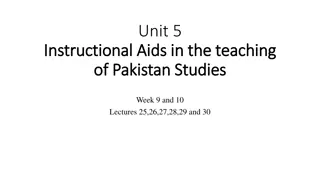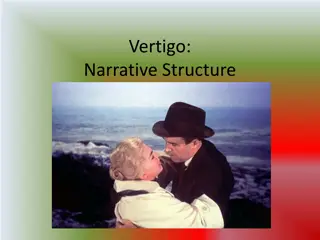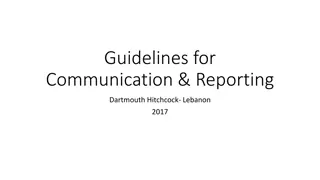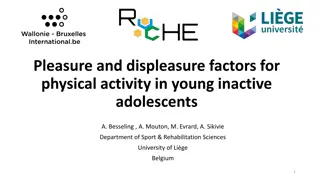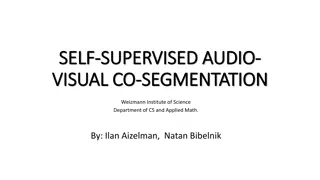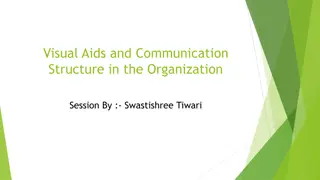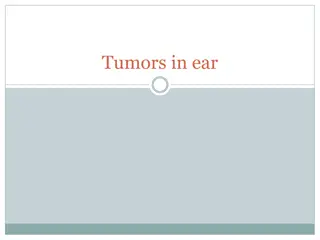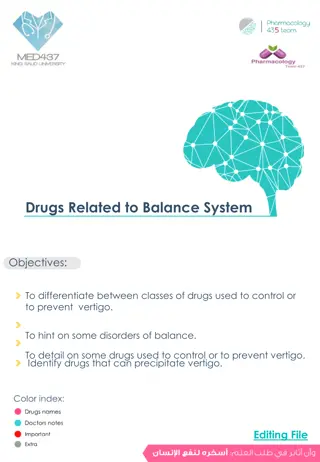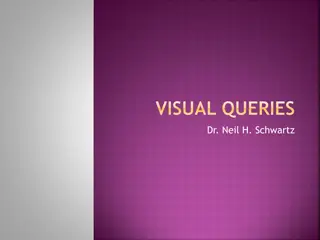Analysis of Visual Pleasure in Hitchcock's Vertigo Through Critical Approaches
Explore critical approaches such as auteur, gendered, genre, and institutional perspectives in analyzing Alfred Hitchcock's Vertigo. Delve into Laura Mulvey's concept of visual pleasure and its relation to cinema, scopophilia, and the representation of women as objects of the male gaze in narrative storytelling.
Download Presentation

Please find below an Image/Link to download the presentation.
The content on the website is provided AS IS for your information and personal use only. It may not be sold, licensed, or shared on other websites without obtaining consent from the author.If you encounter any issues during the download, it is possible that the publisher has removed the file from their server.
You are allowed to download the files provided on this website for personal or commercial use, subject to the condition that they are used lawfully. All files are the property of their respective owners.
The content on the website is provided AS IS for your information and personal use only. It may not be sold, licensed, or shared on other websites without obtaining consent from the author.
E N D
Presentation Transcript
Vertigo Component One
Critical Approaches Auteur Approach Gendered Approach Genre Approach Institutional Approach Auteur- Hitchcock as author of the work Gender- Representation of Women incl: The Male Gaze Genre- Noir and Thriller Institutional- Vertigo as a product of the studio system
Visual Pleasure and Narrative Cinema (1975) Laura Mulvey
Fascination and film; Cinema and Pleasure Film fascinates us (engages our emotions), through images and spectacle Mulvey uses psychoanalysis to discover where and how the fascination of film is reinforced by pre-existing patterns of fascination already at work within the individual subject (= spectator) Hollywood/mainstream/narrative cinema manipulates visual pleasure. It codes the erotic into the language of the dominant patriarchal order .
Scopophilia scopophilia = pleasure in looking (Sigmund Freud 1905, in Three Essays ) examples of the private and curious gaze: children s voyeurism, cinematic looking the most pleasurable looking = looking at the human form and the human face, figural looking (corresponds to psychic patterns)
Woman as image, man as bearer of the look I pleasure in looking split between active/male and passive/female women connote to-be-looked-at-ness the visual presence of women works against the development of a story-line, freezes the flow of action in moments of erotic contemplation
Woman as image, man as bearer of the look II the woman functions as both erotic object for the characters within the screen story and erotic object for the spectator within the auditorium (object of fantasy) the spectator is led to identify with the main male protagonist the power of the male protagonist as he controls events coincides with the active power of the erotic look
The recurring motif of colour is used throughout Vertigo. The colours red and green are predominantly shown and are important. The colour green is used for Madeleine's car, Scottie's clothes and the green light and fog in which Judy/Madeleine steps out of in front of Scottie near the end of the film. This use of the colour green can be viewed to signify the ghostly element of the narrative. The use of the colour red can be seen in the opening sequence of a woman's face, Madeleine's dress, Madeleine's lipstick, the fire at Scottie's house, Ernie's and Carlotta Valdes' necklace. The use of the colour red throughout the film symbolizes the passion and love Scottie has for Madeleine, and also foreshadows the danger ahead of him. The first scene where Scottie sees Madeleine is in Ernie's; the walls are bright red which employs his immediate sense of passion and longing for Madeleine again with the element of danger. For how this connects with gender/ representations of women/ voyeurism, etc- see next slide.
There are theories that Hitchcock explored and interpreted through all of his films, each of these refer to psychoanalytic theories of Freud. The theories Hitchcock explored include scopophilia, castration and the Oedipus complex. The idea of scopophilia is important throughout Vertigo. It is shown through the protagonist Scotty, following Madeleine all the way through Vertigo and his obsession as this increases the further on we get in the film. This obsession relates to his emasculated state, as he uses Madeleine as a means to regain control and therefore regain masculinity. Therefore, all of this is evidence which points to the idea that Vertigo is a film with a deep meaning and is significant to the whole essence of film making. Article Source: http://EzineArticles.com/4573154
Judys Scenes Watch and analyse the scene, making specific reference to key aspects of film form- in the context of the preceding notes on colour, comment on how colour and lighting in particular is used within the sequence.
The key elements of film form- cinematography Madeline s entrance. Novak female, passive, silent, offering herself as an object to the male gaze. The gaze is that of Scottie, a retired detective. He has been asked to come, take a look at her with a view to possibly trailing her for an old college friend. Establishing shot of the restaurant is closely followed by a close up of Scottie at the bar, looking intently over his shoulder into the space of the dining room. The obvious way to develop this with a view to satisfying our curiosity would be to cut to his point of view and an image of Madeline. But like Scottie, we are kept waiting. The camera pans left so that we lose him from the frame and slowly, after pausing for a while the camera begins to slowly move in at the same time as the romantic music begins to play. Only then do we turn back to Scottie and a pattern of alternation develops, cutting between him and his view of them. A series of close-ups between Scottie and Madeleine, culminate in a side profile shot where she s so close he has to, in the next shot, turn away. He is so close he has to hide his gaze so as not to attract her attention or is he so dazzled by her he cannot sustain the gaze?
Visual Motifs- Meaning and Response SPIRALS Spirals evoke the literal and figurative feelings of vertigo that hound Scottie and Madeleine/Judy. The opening credits feature a spiral emerging from a woman s eye. When Scottie looks down from the roof at his fallen colleague, the dead man s limbs are splayed in the shape of a spiral, indicating that events have spiralled out of control. As Scottie observes Madeleine in the museum sitting in front of Carlotta Valdes s portrait, the camera zooms in on the back of her head to reveal a tightly wound spiralling bun, an exact replica of the style worn by Carlotta. The spiral foreshadows the dizzying chaos into which Madeleine will lead Scottie. The most physically jarring spiral is the one formed by the winding stairs of the bell tower as revealed from Scottie s perspective. As he chases Madeleine up the stairs attempting to halt her apparent suicide, his acrophobia takes over and the camera shoots straight down the stairwell. His vertigo has made him powerless to save the woman he loves. The very structure of the film suggests a spiraling circularity: Scottie falls in love with Madeleine, loses her to death, then falls in love with Judy/Madeleine again, only to lose her to death as well. LINK WITH NOIR/ HOLLYWOOD/ MALE IMPOTENCE
The Male Gaze This transfer of sympathies from the male to the female raises interesting questions about Hitchcock s intentions. You ll note how Hitch lingers in Judy s apartment as the twist is revealed, and has us literally inside her head during her and Scottie s walk through the park. We get Novak s POV, not Scottie s, and she sees a happy couple laying in the grass, amidst fluttering birds and optimistic music. In this new light, the twisted tale becomes a masterful meditation on the male ego and the unattainable woman. We feel for Judy as she is repeatedly subjected to Scottie s attempts to remake her into his ideal object and looks up at him with those tragic eyes to say, Couldn t you like me? Just me, the way I am?
It is both a delicious ode to the helpless male fantasy and a scathing commentary supported by even the most strident feminist. As with all of Hitchcock s films, one can debate whether it is a sick example of the male gaze, or a useful window into the dangers of the male gaze. I prefer the latter. While I agree with Laura Mulvey that Rear Window and Vertigo cut to the measure of the male desire, (E) I think the point is for us to admit and question that desire. It s no coincidence that we begin to see Scottie in a different light, and we don t like what we see. This is the true lesson of the film.
Vertigo as product of the Studio System What distinguished the Hollywood Studio System? An Oligopoly: A limited number of studios--five "majors , three "minors", Disney, and two independent producers.
What distinguished the Hollywood Studio System? Moguls: The importance of a handful of similar men in formulating the system 3306794
What distinguished the Hollywood Studio System? A large physical plant: soundstages and backlots other facilities that ensured the independence of the studio (e.g., fire station, medical center, sleeping bungalows, restaurants)
What distinguished the Hollywood Studio System? A stable of crew and contract players (both stars and bit players); e.g., Donna Reed, Jimmy Stewart, Thomas Mitchell, Beulah Bondi, Lionel Barrymore, Ward Bond, Frank Faylen from It s a Wonderful Life (1946) See full size image
Jimmy Stewart (George Bailey)100 films & TV series/appearances The Murder Man (1935) After the Thin Man (1936) You Can t Take it With You (1938) Mr. Smith Goes to Washington (1939) The Philadelphia Story (1940) Rear Window (1954) Vertigo (1958) How the West Was Won (1962)
What distinguished the Hollywood Studio System? The star system the "grooming" of stars under contract star vehicles
The Independents: Selznick International Mogul: David O. Selznick Genres: Mysteries, epics Stable: Ingrid Bergman, Gregory Peck, Joseph Cotten, Joan Fontaine, Jennifer Jones, Hitchcock (early) Other: Produced many star vehicles for the stars under "personal" contract Roots: Truly an independent producer
Hollywood- old and new In relation to Hollywood as a studio system, Hitchcock was in an almost unique position, having arrived in the US under contract to the independent producer David O. Selznik and later operating with a large degree of autonomy and control as head of his own production unit on the studio lots of the majors on short-term contracts. These features of Hitchcock s work make it possible to argue strongly for Hitchcock as a producer-director of personal projects during his Hollywood career. Even so, the auteurist argument is still undermined by the fact that anything labelled Hitchcockian in the films of Alfred Hitchcock must also be considered in terms of Hitchcock s regular collaborators including such influential figures as his wife Alma Reville as script editor, Bernard Herrmann as composer, Robert Burks as cinematographer and a number of key actors such as Cary Grant and James Stewart. Hitchcock s projects were carefully selected but they were often adaptations, so rather than originating film narratives, Hitchcock could be said to have developed and presented them in his own style and with his own highly personal vision.
Film Noir Term applied by French critics to a group of U.S films made during the war. Film noir is a cinematic term used primarily to describe stylish Hollywood crime dramas. Film noirs tend to emphasize cynical attitudes and sexual motivations. Hollywood's classic film noir period is generally regarded as stretching from the early 1940s to the late 1950s. Film noir of this era is associated with a low-key black-and-white visual style that has roots in German Expressionist cinematography. Many of the prototypical stories and much of the attitude of classic noir derive from the hardboiled school of crime fiction that emerged in the United States during the Depression.
Visual Style The low-key lighting schemes of many classic film noirs are associated with stark light/dark contrasts and dramatic shadow patterning a style known as chiaroscuro. The shadows of Venetian blinds or banister rods, cast upon an actor, a wall, or an entire set, are an iconic visual in noir. Characters' faces may be partially or wholly obscured by darkness a relative rarity in conventional Hollywood moviemaking.
Visual Style The low-key lighting schemes of many classic film noirs are associated with stark light/dark contrasts and dramatic shadow patterning a style known as chiaroscuro. The shadows of Venetian blinds or banister rods, cast upon an actor, a wall, or an entire set, are an iconic visual in noir. Characters' faces may be partially or wholly obscured by darkness a relative rarity in conventional Hollywood moviemaking. See Judy in her apartment scenes- duplicitity.
How does lighting convey character? What atmosphere is being created through the lighting? What messages and values are being suggested as a result?
Male world, male audience. Film Noirs were often aimed at male audiences. Their protagonists were almost invariably men, usually detectives or criminals characterised by pessimism, self doubt, or a cold detached view of the world. Where does Scotty fit within this context? Does his vertigo and traumatic experience detach him from the real world?
Women in Film Noir Women as femme fatale Mad, bad and dangerous to know Usually sexually alluring but treacherous, leading men; the protagonist into danger or using them for for their own selfish ends. How does Judy/ Madeline conform to this representation of the female? How does Madeline? Or is Madeline the embodiment of female virtue?
Themes The Haunted Past: Noir protagonists are often creatures of the night- they are often seeking to escape some past burden or trauma or even just their own demons- they seek concealment in dark alleys and dimly lit rooms that proliferate the world of noir. One cannot escape one s past- see Madeline, Scottie and Judy. The Fatalistic Nightmare: The noir world revolves around causality. Events are linked like an unbreakable chain and lead inevitably to a foreshadowed conclusion The perfect crime: Conspiracy and betrayal, love and sex, murder and the perfect crimes, male violence- all are key themes of the Film Noir.
Archetypes The truth seeker- not always a private investigator, often an officer of the law, a criminal, rarely a woman. The Hunted- often a male, often an outsider. The Femme Fatale- most subversive element in Film Noir- the femme fatale/ the black widow has recently been rescued by feminist critics as strong, seductive women often rebelling against a male dominated society, willing to use any weapon, including their own sexuality to level the playing field. Which roles can you recognize within Vertigo?
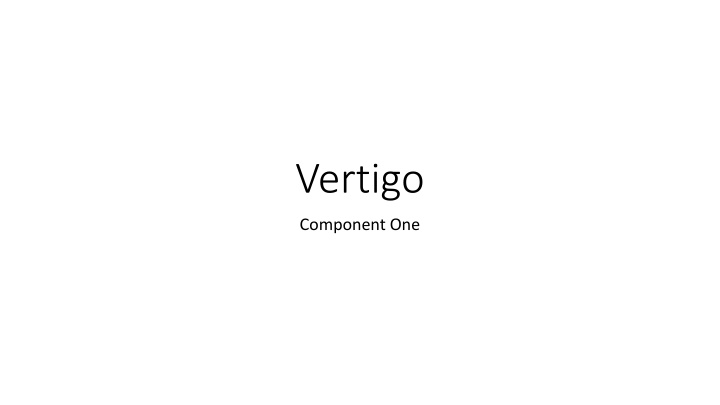

![textbook$ What Your Heart Needs for the Hard Days 52 Encouraging Truths to Hold On To [R.A.R]](/thumb/9838/textbook-what-your-heart-needs-for-the-hard-days-52-encouraging-truths-to-hold-on-to-r-a-r.jpg)


